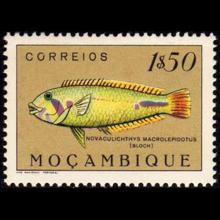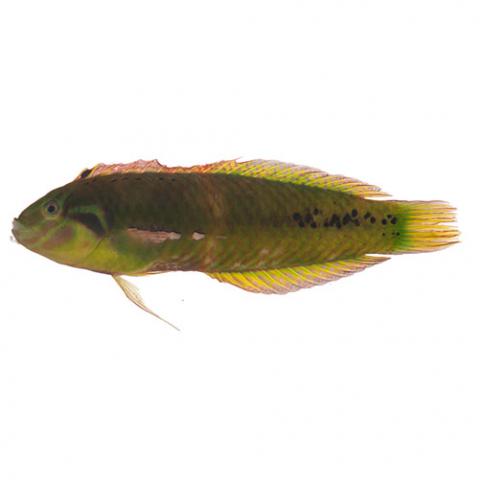NAMES
TAXONOMY
Mozambique
Issued:
Stamp:
Novaculoides macrolepidotus
Mozambique
Issued:
Stamp:
Novaculoides macrolepidotus
Mozambique
Issued:
Stamp:
Novaculoides macrolepidotus
Genus species (Animalia): Novaculoides macrolepidotus
The seagrass wrasse, Novaculoides macrolepidotus, is a species of wrasse native to the Indian Ocean and the western Pacific Ocean. It can be found in lagoons and mangrove forests in seagrass beds or on sandy areas with plentiful algal growth. It occurs at depths from the surface to 10 m (33 ft). This species grows to 16 cm (6.3 in) in total length. It can be found in the aquarium trade. This species is the only known member of its genus. The juveniles and smaller adults of this species are Batesian mimics of the venomous waspfish in the genus Ablabys. When threatened, these fish dive headfirst into the sea grass or sea weed beds they inhabit.
Anatomy
Wrasses have protractile mouths, usually with separate jaw teeth that jut outwards. Many species can be readily recognized by their thick lips, the inside of which is sometimes curiously folded, a peculiarity which gave rise the German name of "lip-fishes" (Lippfische). and the Dutch name of lipvissen. The dorsal fin has eight to 21 spines and six to 21 soft rays, usually running most of the length of the back. Wrasses are sexually dimorphic. Many species are capable of changing sex. Juveniles are a mix of males and females (known as initial-phase individuals), but the largest adults become territory-holding (terminal-phase) males.
The wrasses have become a primary study species in fish-feeding biomechanics due to their jaw structures. The nasal and mandibular bones are connected at their posterior ends to the rigid neurocranium, and the superior and inferior articulations of the maxilla are joined to the anterior tips of these two bones, respectively, creating a loop of four rigid bones connected by moving joints. This "four-bar linkage" has the property of allowing numerous arrangements to achieve a given mechanical result (fast jaw protrusion or a forceful bite), thus decoupling morphology from function. The actual morphology of wrasses reflects this, with many lineages displaying different jaw morphology that results in the same functional output in a similar or identical ecological niche.
Reference: Wikipedia
Photo: American Museum of Natural History


